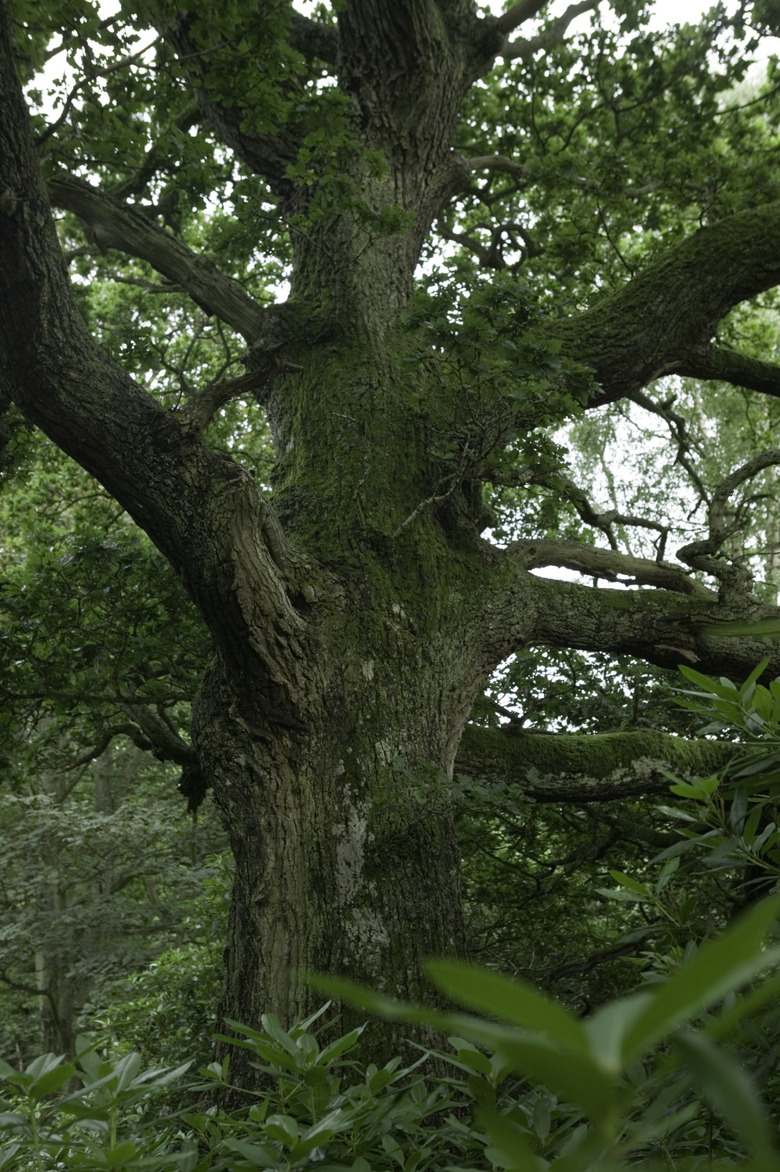What Insecticide Kills Oak Borers?
Oaks (Quercus spp.) are stately trees that provide large areas of shade for the kids to play in or for family get-togethers. They are generally hardy in U.S. Department of Agriculture plant hardiness zones 2 to 11, although this varies slightly depending on the species. While they are robust, long-lived trees that are not as susceptible to diseases and insect attacks as many other shade tree species, borers can kill them under certain circumstances. The strategic use of insecticide to prevent severe infestations may save the tree.
Boring Insects
Step 1
Certain species of beetles and moths are boring insects that attack oak trees. The serious damage is usually caused by larvae tunneling through and eating the wood just beneath the bark, but not always. Twig girdler beetles chew V-shaped furrows in the bark around oak tree branches and twigs, then lay their eggs in the furrows. The most common signs of boring insect attacks are wet, sappy spots on the bark where the beetle or moth laid its eggs, sawdust-like frass just below the sappy spot, wilting or dying branches and small holes where the adult beetles or moths exited the tree.
- are stately trees that provide large areas of shade for the kids to play in or for family get-togethers.
- The most common signs of boring insect attacks are wet, sappy spots on the bark where the beetle or moth laid its eggs, sawdust-like frass just below the sappy spot, wilting or dying branches and small holes where the adult beetles or moths exited the tree.
Boring Insect Damage
Step 1
Borer damage disrupts the flow of water and nutrients to the parts of the tree beyond where the borer was feeding. Some borers will attack individual branches, but others will attack the trunk. Branches that have been seriously damaged should be pruned off to prevent them from falling on people below. Do not leave the infested branches near other trees or plants, as the beetles left in them can quickly move on to infest other trees. Cut them into shorter sections and wrap the sections tightly in heavy clear plastic. Leave the wrapped sections in the hot sun for several months to kill the insects. If there is serious damage on the trunk of the tree, it will likely die regardless of the use of insecticide, and should be removed so that it does not fall on people or your house.
- Borer damage disrupts the flow of water and nutrients to the parts of the tree beyond where the borer was feeding.
- If there is serious damage on the trunk of the tree, it will likely die regardless of the use of insecticide, and should be removed so that it does not fall on people or your house.
Insecticide Treatment for Borers
Step 1
A light infestation with minimal damage can be treated with insecticide, but the treatment must be carefully timed. Insecticide will not kill the borers beneath the bark. It must be sprayed before the borers lay their eggs in order to kill the adults and interrupt the cycle. The insecticide must be sprayed immediately when an adult borer is seen around the tree. The majority of oak boring insects can be killed by an insecticide containing chlorpyrifos. The insecticide is mixed with water, poured into a pressure sprayer and sprayed on the tree trunk and branches. The dilution rate depends on the insect. For clearwing moths, 2/3 ounce of chlorpyrifos is mixed into 1 gallon of water. For beetles like oak ambrosia or oak bark beetles, 5 1/3 ounces of chlorpyrifos is mixed into 1 gallon of water. The insecticide should not be sprayed on a windy day and people and pets must stay away from the tree until the insecticide is completely dry. This pesticide can only be purchased and sprayed by a licensed professional.
- A light infestation with minimal damage can be treated with insecticide, but the treatment must be carefully timed.
- The insecticide is mixed with water, poured into a pressure sprayer and sprayed on the tree trunk and branches.
Maintaining Oak Tree Health
Step 1
While boring insects will attack healthy oak trees, they usually attack oaks that are stressed and unhealthy or have been injured. Taking good care of an oak tree can prevent infestation or help the tree survive after being attacked. During dry periods, water the tree every two weeks or so. A mature oak will need about 10 gallons of water for 20 square feet of crown or canopy. Apply the water evenly over the ground below the leaves and 5 or 6 feet beyond the edge of the canopy. Give the oak 12-6-6, 18-6-12 or 10-8-4 tree fertilizer after the first hard fall frost or just before it begins to grow new leaves in the spring. Apply 2 pounds of fertilizer over the soil beneath the leaves and 5 feet beyond the edge of the canopy.
- While boring insects will attack healthy oak trees, they usually attack oaks that are stressed and unhealthy or have been injured.
- Apply the water evenly over the ground below the leaves and 5 or 6 feet beyond the edge of the canopy.
References
- Utah State University Cooperative Extension: Forestry: Oaks for Utah
- Floridata: Quercus Virginiana
- University of California Integrated Pest Management Program: Pests in Gardens and Landscapes: Bark Beetles
- University of Minnesota: Specimen Label: Dursban Pro
- North Carolina State University: Watering Shrubs
- University of Missouri-Columbia: Fertilizing Shade Trees
